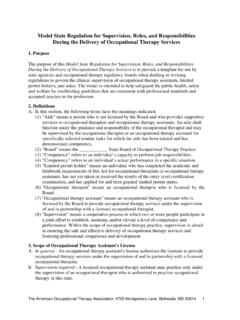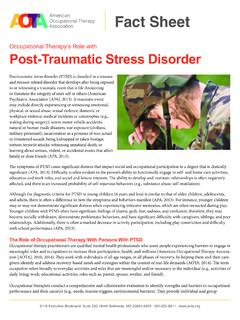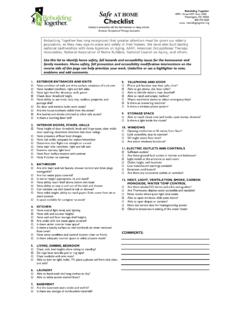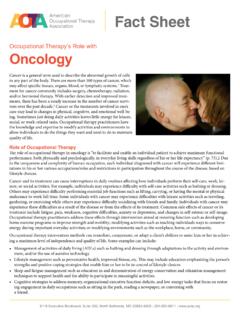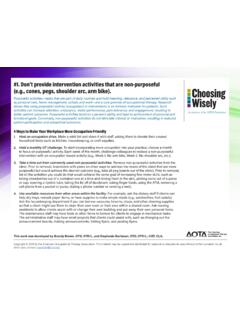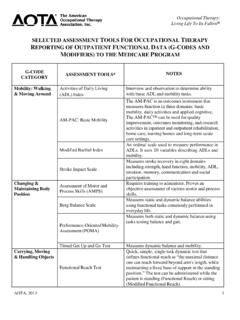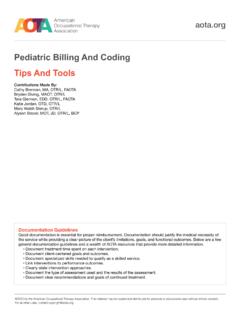Transcription of Managing Obesity in Adults: A Role for Occupational Therapy
1 CE-1 ARTICLE CODE CEA1118 | NOVEMBER 2018 Earn .1 AOTA CEU (one contact hour and NBCOT PDU). See page CE-7 for Education ArticleCE-1 ARTICLE CODE CEA1118 | NOVEMBER 2018 Managing Obesity in Adults: A Role for Occupational TherapyCamille Dieterle, OTD, OTR/L Mrs. Chan Division of Occupational Science and Occupational TherapyUniversity of Southern California, Los Angeles, CA This CE Article was developed in collaboration with AOTA s Rehabilitation & Disability Special Interest Therapy practitioners commonly encounter clients diagnosed with or who are at risk for Obesity across all popu-lations and settings. Because Obesity can affect participation in occupation, Occupational Therapy practitioners can treat Obesity as the primary condition or reason for referral, as well as in conjunction with various conditions and disabilities.
2 This article focuses on the effects of Obesity on Occupational perfor-mance and participation and discusses Occupational Therapy lifestyle interventions for treating Obesity with adults who are or who are at risk for Obesity , including primary, secondary, and tertiary prevention and bariatric surgery. The article focuses on intervention in the context of outpatient lifestyle modifica-tion, although much of the material discussed is useful in most settings. LEARNING OBJECTIVESA fter reading this article, you should be able to:1. Identify the various client factors, performance patterns, con-texts, and environments that contribute to the effects of Obesity on occupation and Occupational Therapy s role in treating obesity4.
3 Describe evidence-based Occupational Therapy lifestyle mod-ification interventions for reducing weight and preventingweight gainINTRODUCTIONMore than 70% of American adults are either overweight or obese. Adult Obesity rates have been rising steadily since the 1970s. In 2015 and 2016, of adults in the United States were categorized as obese (Hales et al., 2017). Another of adults were categorized as overweight (Centers for Disease Con-trol and Prevention [CDC], 2017b). Black and Hispanic adults have a higher rate of Obesity than white or Asian adults (Hales et al., 2017). Overweight and Obesity are defined by body mass index (BMI), which is the ratio of weight to height.
4 BMI is calculated in a clinical setting by measuring overall weight and height and then using a chart or online calculator to calculate BMI. A BMI of 25 to 30 is considered overweight. A BMI 30 or higher is considered obese (Centers for Disease Control and Prevention [CDC], 2016). Obesity is divided into further categories: class 1 (BMI 30 35), class 2 (35 40), and class 3 (40 or higher). BMI is a useful screening tool, but it has limitations. For example, it does not indicate how much body fat a person has, and people with high muscle mass and low fat mass may have a high BMI. Waist circumference is another measure used. In adults, a waist circumference greater than 35 inches for females and 40 inches for males indicates a higher risk for Obesity -related conditions (Jensen et al.)
5 , 2013).Not all people with high BMI experience poor health, but people who are obese are at an increased risk for all causes of death (mortality); hypertension; high LDL and low HDL cholesterol; high levels of triglycerides (dyslipidemia); Type 2 diabetes; metabolic syndrome; coronary heart disease; stroke; gallbladder disease; osteoarthritis (especially both knees); sleep apnea and breathing problems; some cancers (endometrial, breast, colon, kidney, gallbladder, and liver); breast cancer relapse; fatty liver disease; kidney disease; pregnancy problems; low quality of life; mental illness, such as clinical depression, anxiety, and other mental disorders.
6 Body pain; and difficulty with physical functioning (CDC, 2017a; Dieli-Conwright et al., 2018; National Institute of Diabetes and Digestive and Kidney Diseases, 2015). Additionally, social stigma and discrimination based on weight can affect mental health, especially in the form of mood disorders and decreased quality of life (Barclay & Forwell, 2018). Stigma and discrimination from within the health care system and from society at large can contribute to decreased engagement in self -care and decreased access to health care, which can lead to additional health problems (Tylka et al., 2014). Earn .1 AOTA CEU (one contact hour and NBCOT PDU).See page CE-7 for CODE CEA1118 | NOVEMBER 2018 CE-2 ARTICLE CODE CEA1118 | NOVEMBER 2018 Earn.
7 1 AOTA CEU (one contact hour and NBCOT PDU). See page CE-7 for Education ArticleCE Article, exam, and certificate are also available ONLINE. Register at or call toll-free 877-404-AOTA (2682).EtiologyThe most common causes of weight gain, which leads to Obesity , include genetics, environmental influences, medical conditions, disabilities, medications, food choices, meal timing, chronic sleep deprivation, long-term stress (elevated cortisol), and aging. Some of these causes are modifiable and some are not. A tendency for Obesity can be passed down through genetics (Tylka et al., 2014). Environmental causes for weight gain can start in utero with maternal nutrition (Parlee & MacDougald, 2014), and physical and social environments can have signifi-cant effects on weight gain throughout the life span.
8 Elements of an obesogenic environment include unhealthy food choices/energy intake, poverty, sleep deprivation, sedentary lifestyle, and inactive work (Bellisari, 2013; Kuo et al., 2013). Lack of access to healthy food, opportunities for physical activities, and access to green spaces are also identified causes, as is an increase in sedentary leisure activities (Gonz lez et al., 2017; Kuo et al., 2013). Drieling and colleagues (2014) found that community resources that provide health education are associated with more physical activity and better diet, which can be an asset for Obesity -reduction strategies. However, there is a need for better resource promotion, given the low utilization of these afford-able educational community resources (Drieling et al.)
9 , 2014). Exposure to obesogenic chemicals, such as nicotine, flame retardants, bisphenol A, some pesticides, and polychlorinated biphenyls may increase the risk for weight gain and are thought to be most hazardous in utero and in early childhood, when the body s weight control mechanisms are being formed (Kelishadi et al., 2013). Medical conditions that commonly cause weight gain include underactive thyroid; polycystic ovarian syndrome; Cushing s syndrome; and mental illnesses, such as depression, anxiety, posttraumatic stress disorder, binge eating disorder, and night eating syndrome (Assari, 2014; National Health System, 2017). Conditions that limit mobility and engagement in occupation can also increase the likelihood of weight gain, including phys-ical disabilities and mental illness (Saliman Reingold & Jordan, 2013).
10 menopause , perimenopause, and aging can cause weight gain as well (Porter, 2016). Medications that commonly cause weight gain include steroid therapies; diabetes medications ( , insulin, thiazolidinediones, sulfonylureas); psychiatric/neurologic therapies ( , tricyclic antidepressants, selective serotonin reuptake inhibitors); antipsychotics, which are the most likely to cause weight gain; antiseizure/anticonvulsants; antihistamines; and beta-adrenergic blockers, used to lower blood pressure (Kyle & Kuehl, 2018). Medical treatment may also cause weight gain. Chemotherapy can cause weight gain and the development of metabolic syndrome, which is a com-bination of high blood pressure, high cholesterol, and excessive body fat (Dieli-Conwright et al.)
